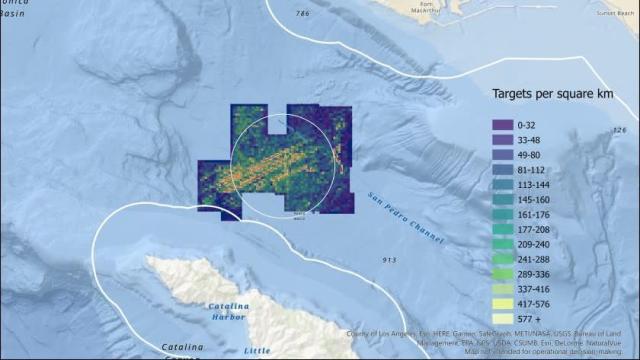A known DDT dump site off the coast of Southern California is considerably larger than suspected, in a discovery that’s sounding the alarm bells.
Finding 2,500 barrelswould’ve been a lot. Same for 250 barrels. Heck, even the discovery of 25 barrels at a former DDT dumpsite would’ve been upsetting. But 25,000 barrels? That’s astonishingly awful and unquestionably scary.
But such is the result of a recently concluded survey led by the University of California, San Diego’s Scripps Institution of Oceanography. From March 10 to 24, a team of researchers mapped 14,000 hectares across a stretch of seafloor between Santa Catalina Island and the Los Angeles coast. This area was previously identified as a hotspot for DDT — a notorious pesticide that’s now banned around the world owing to its toxicity.
Back in 2011 and 2013, David Valentine, a research scientist at the University of California, Santa Barbara, detected concentrated levels of DDT in sediments at this location, along with 60 barrels suspected of containing DDT-laced sludge. Alarmingly, other scientists detected elevated levels of the toxic chemical in dolphins and sea lions.
That this Southern California ocean basin should yield some toxic waste is hardly surprising, though the new estimates of how much is there is nevertheless shocking. The dumping of industrial waste began here during the Great Depression era, while archival shipping logs from a waste disposal company suggest 2,000 barrels of DDT-laced sludge were dumped here every month from 1947 to 1961, according to a Los Angeles Times investigation. Industrial companies continued to use this area as their toilet until the enactment of the Marine Protection, Research, and Sanctuaries Act, also known as the Ocean Dumping Act, in 1972.
To get a better picture of how many barrels might actually be located in this area, the Scripps Institute, in partnership with NOAA’s Office of Marine and Aviation Operations and the National Oceanographic Partnership Program, organised the new expedition. Riding aboard the R/V Sally Ride, the team of 31 scientists, engineers, and crew used a pair of robotic subs equipped with sonar to scan the bottom at high resolutions. One at a time, the subs slunk to depths reaching 914 metres, scanning the equivalent of 140 football fields each hour.
“We couldn’t keep up with the flow of data coming in,” Eric Terrill, the leader of the expedition and a scientist at Scripps, told the Los Angeles Times. The team found a massive debris field littered with more than 100,000 individual objects. In total, they gathered more than 100 gigabytes of data, requiring a specialised algorithm to make sense of it all.
Nearly 25,000 items were confidently identified as being barrels, both because of their unique sonar signature and the pattern of distribution along the seafloor. The team says this number could be as high as 27,000, or even higher, as the computer algorithm may have missed barrels partially buried in sediment.
“There are several distinct track-line patterns in the surveyed area, suggesting that the dumping was repeatedly done from an underway platform such as a moving ship or barge. Some of those lines are as long as 18 km and approach state waters,” explained Terrill in a Scripps Institute press release. “While our mapping sonars cannot measure the contents inside the barrels, the target locations are consistent with the previously identified dumpsite and extend much further than we expected.”
Indeed, many objects were detected outside of the dumpsite limits, including areas a mere 19 kilometres from Los Angeles, and 8 kilometres from Catalina Island.
“The uniquely high body burden of DDT in top predators feeding in Southern California waters has been known for some time,” Lihini Aluwihare, a geoscientist and chemical oceanographer at the Scripps Institution who wasn’t involved with the expedition, said in the press release. “The extent of the dumping ground helps to explain some of these previous observations.”
At a Congressional briefing held Monday, Sen. Dianne Feinstein said she will ask the Justice Department to name the companies that might be responsible for the illegal dumping of waste, and then determine if “they can be held accountable,” the Los Angeles Times reported.
This finding should ideally instigate the development of an action plan to deal with the situation, such as finding a safe and effective way of removing the barrels before they leak any further. Scientists should also study the potential effects of DDT on the food web to assess the chemical’s ongoing influence in the ocean.
